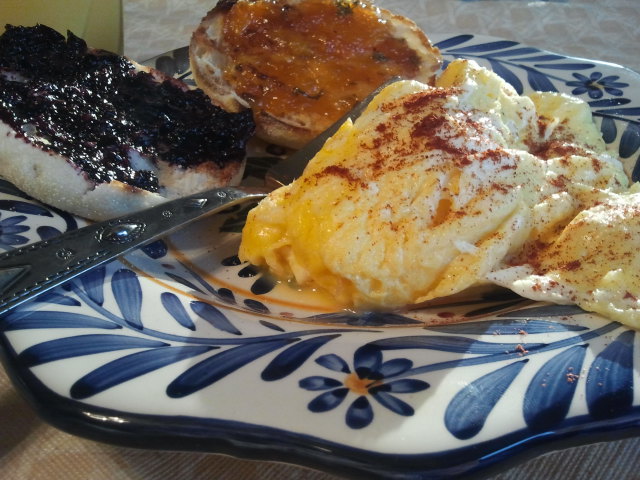Tips for Better Scrambled Eggs
I have a confession to make.
I’ve never made scrambled eggs well.
It’s not that they’ve been inedible or even half-bad. They’ve just never been really… good. They either end up doing an overcooked backstroke* around the plate or they wallpaper the pan. Both of these problems are somewhat alleviated by adding extras like sausage or cheese or peppers. But only in the way that putting a hat on fixes a bad hair day.
In the past few weeks however, my stars have unscrambled and a series of fortunate events have pushed better egg cookery upon me. These events are fairly mundane– a dirty pan, extra bacon grease, a distracted mama– but together they produced a breakfast that was anything but a jumbled up mess.
Tips for Better Scrambled Eggs:
- Use an appropriately sized pan. I’ve found it better to do single servings (2-4 eggs) in an 8 in pan rather than large batches in a 12 in pan. Using too big of pan seems to result in overcooked watery eggs, probably because they cook too fast to manipulate them properly.
- Use enough fat. Seriously. Even I, who have no fear of fat, evidently have not been using enough. Using at least 2 Tbs per serving seems to eliminate the eggy wallpaper problem. I know non-stick pans are supposed to be the Holy Ovum, I just don’t trust them. Even if you only use plastic utensils (an issue unto itself) they still get scratched. And where does all that stuff go? I shudder to think how much Teflon I’ve ingested. Besides, fat adds flavor. Butter is a natural companion to eggs, but I typically use bacon grease that I save in jar in the fridge. Frugal and tasty– what more can a cook ask for?
- Let the pan get hot enough before adding the eggs. This is another reason to forgo the non-stick pans as it’s dangerous to heat an empty Teflon pan. The beaten eggs should sizzle as you pour them into the pan and immediately begin to cook around the edges.
- Take them out of the pan before they are completely done. Eggs continue to cook after being removed from heat. So if you “go all the way” in the pan, you’ll be left with something less than the best on the plate. This step takes practice. After all, how to you know when they are “almost done” and not just undercooked? Only in the scrambling of many eggs will you learn, young eggdi, Yoda says. (Yes, I did just do that.)
- Cheese confuses this whole processes. It’s Meltiness sticks to the pan no matter how much fat you use. I suggest staying away from it until you get your Scramble on better. If you can’t do without it, try sprinkling it over the eggs on the plate rather than in the pan.
This list is far from exhaustive, I know. Some of your technique will depend on how you like your eggs. For example, I prefer a cohesive lump rather than a thousand tiny curds. So I tend to flip my eggs rather than break them up by stirring. What about all of you? How do you like your eggs? What techniques do you use to get the perfect Scramble?
*Eggs get watery when overcooked because the proteins have contracted too much and pushed all the liquid out. Therefore, cooking the eggs more will only exacerbate the problem.


My biggest priority when cooking scrambled eggs is not to leave my cast-iron skillet a mess, because I cook breakfast in it pretty much every morning. I have gotten good enough at it that there is only the odd little piece of dried-up egg edge that I can just lift off the The next morning, and I don’t have to wash it at all. I don’t know how good the eggs are from a culinary perspective because i have never really liked any scrambled eggs, but they’re done the way I can eat them–not too wet. The key for me is your #3–the pan must be nice and hot. My breakfast routine takes care of this pretty well because I do home fries in there first. When they’re done I push them over to the side and pour in just enough egg that it doesn’t run into them (my burner isn’t quite level). The pan is hot enough that the eggs touching it cook instantly and don’t stick or “wallpaper the pan” as you put it! Then I lift that part up, pour in the rest, etc. I try to wait until Joel has already poured his coffee and is ready to eat and serve them immediately because they cook really fast and there’s nothing worse than cold eggs!!
Oh and I manage to do this with just a little dab of fat scooped on the end of a knife, per 2 eggs. Not that I’m fatphobic either but I never have bacon anymore and coconut oil and ghee are expensive.
Don’t use any salt until the end–it denatures the whites, lots of bacon or butter (or heck, both), use a rubber spatula to gently squoosh? thru the center over and over until almost done, get them from fabulous heritage chickens.
I love eggs!
Oh yeah, I’ve also heard not to use salt because it makes them tough. So I stopped but I haven’t noticed any difference.